In the vast tapestry of the animal kingdom, there is an incredible diversity of adaptations that allow creatures to thrive in their respective habitats. While some animals are gifted with impressive eyesight, capable of discerning even the minutest details, others possess eyes that are surprisingly small in proportion to their bodies. These diminutive organs of vision have evolved to suit the unique needs and lifestyles of these fascinating creatures.
In this article, we delve into the captivating world of the top ten animals with the smallest eyes. From the subterranean dwellers to the majestic giants, we explore how these animals navigate and perceive the world around them despite their seemingly inconspicuous visual apparatus. We will uncover the remarkable ways in which these small eyes play a vital role in their survival, shedding light on the intricacies of evolution and adaptation.
1. Vaquita:

Vaquitas are small
porpoises
with tiny eyes.
©Paula Olson, NOAA, Public domain, via Wikimedia Commons – License
The vaquita, a small porpoise species, possesses eyes that are relatively small in proportion to its body size. As one of the smallest cetaceans, these elusive marine mammals have a petite frame with a streamlined shape. Their eyes, although small, play a crucial role in their survival in the Gulf of California. With their diminutive eyes, vaquitas rely on their keen hearing and echolocation abilities to navigate their murky habitat. Due to their small eyes, vaquitas may not possess exceptional visual acuity, but they compensate for this with their other sensory abilities, enabling them to locate prey, avoid predators, and communicate with each other in their watery world.
2. Gorilla:
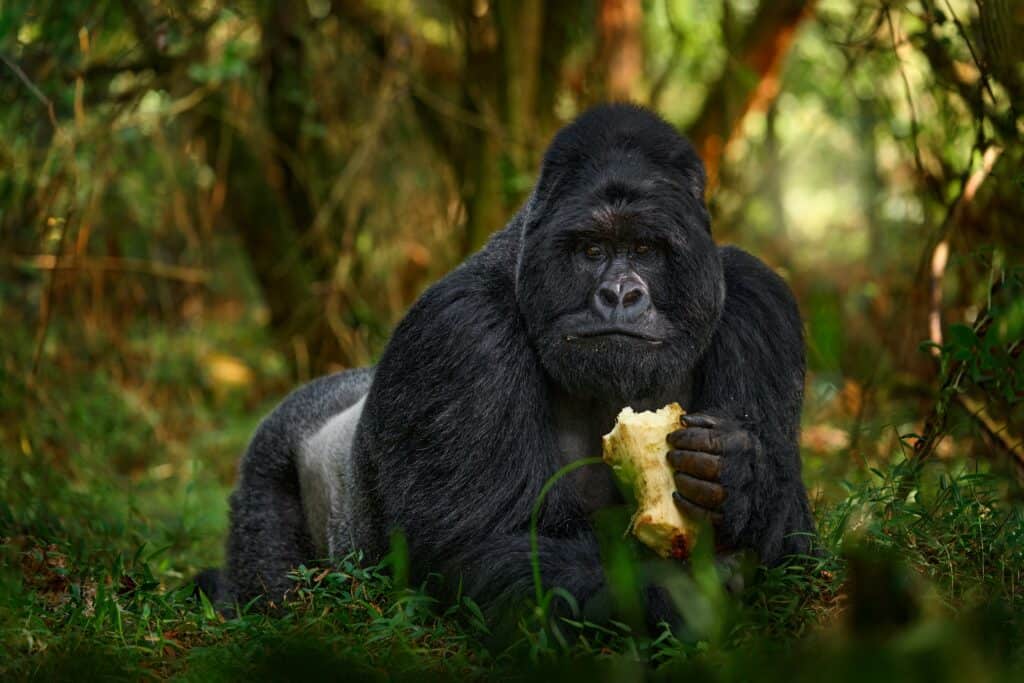
Uganda
mountain gorilla
with food. Compared to their large bodies, Gorillas have small eyes.
©Ondrej Prosicky/Shutterstock.com
Gorillas are powerful primates known for their immense strength and large size. Despite their impressive stature, gorillas have relatively small eyes in proportion to their bodies. Set into their hairless faces, these small eyes may not provide the same level of visual acuity as some other animals. However, gorillas rely on their exceptional memory and well-developed senses to navigate their surroundings. With their keen hearing and sense of smell, gorillas can effectively communicate with each other and detect potential threats or sources of food. While their small eyes may not be their primary sensory tool, they contribute to the overall appearance of these magnificent creatures.
3. Spotted Bat:
The spotted bat, a unique species of bat found in North America, is known for its striking appearance and small eyes. While it boasts the largest ears among North American bat species, its eyes are relatively small in proportion to its body size. These small eyes may not provide the same level of visual acuity as some other animals, but the spotted bat compensates for this with its exceptional echolocation abilities. Emitting high-pitched sounds, the bat utilizes echolocation to navigate and locate prey in the darkness of night. Despite its diminutive eyes, the spotted bat thrives in its habitat, relying on its unique adaptations to survive and thrive.
4. Horseshoe Crabs:
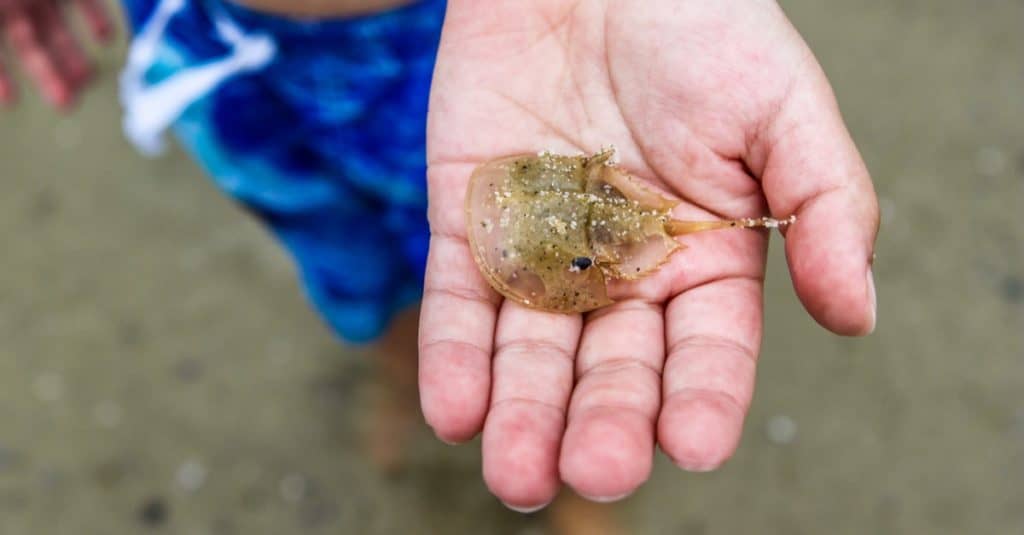
A child holding a baby horseshoe crab in the hand on a beach. These crabs have a small set of 10 eyes you can barely see.
©Kim Miller Media/Shutterstock.com
Horseshoe crabs, ancient marine arthropods, possess a remarkable anatomy, including a set of eyes that are relatively small in proportion to their bodies. They have ten eyes in total, including a pair of compound eyes on their prosoma. These compound eyes, although small, provide horseshoe crabs with a broad field of vision, allowing them to detect movement and changes in light intensity. While their eyes may not possess the same level of visual acuity as some other animals, they serve as an important sensory tool for these fascinating creatures. Their small eyes contribute to the overall intricacy of horseshoe crab biology and their ability to adapt to their marine environment.
5. Sharks:
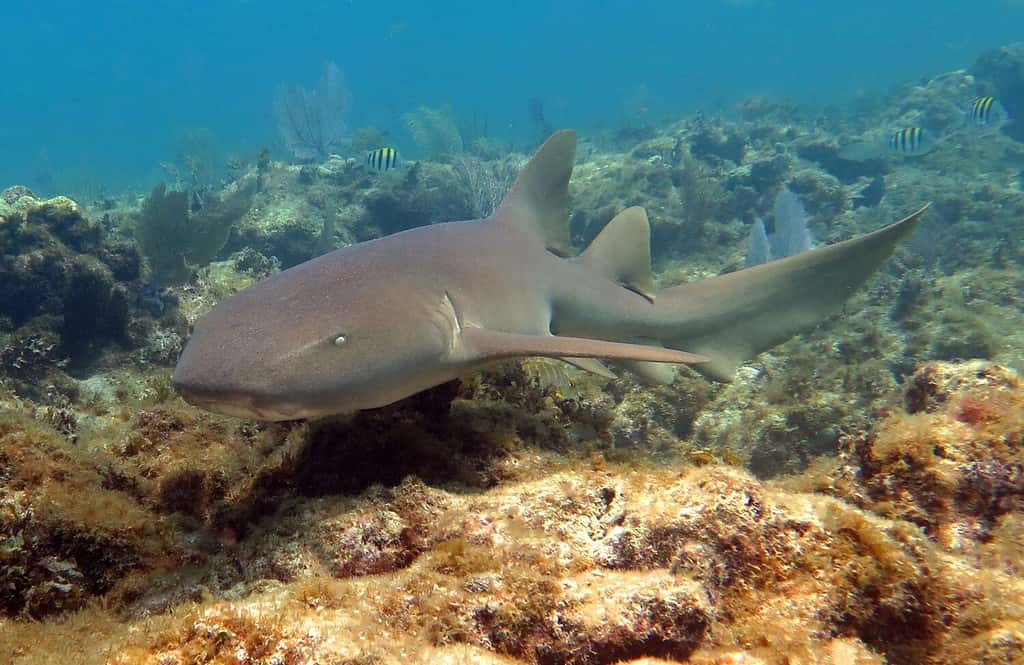
Shark species tend to have small eyes in proportion to their bodies and rely on their acute sense of smell for capturing their prey.
©Daryl Duda/Shutterstock.com
Sharks, renowned predators of the oceans, possess eyes that are relatively small compared to their body size. Despite their small size, these eyes play a crucial role in their predatory lifestyle. Sharks have excellent vision, adapted to their aquatic environment. Their small eyes are equipped with specialized structures that enhance their ability to see in low light conditions and detect movements underwater. While their eyes may not be as large as those of some other marine creatures, sharks rely on their other senses, such as their acute sense of smell and ability to detect electrical signals, to locate prey and navigate their surroundings. Their small eyes contribute to their streamlined and efficient hunting capabilities, making them formidable predators in the oceanic realm.
6. Mole:
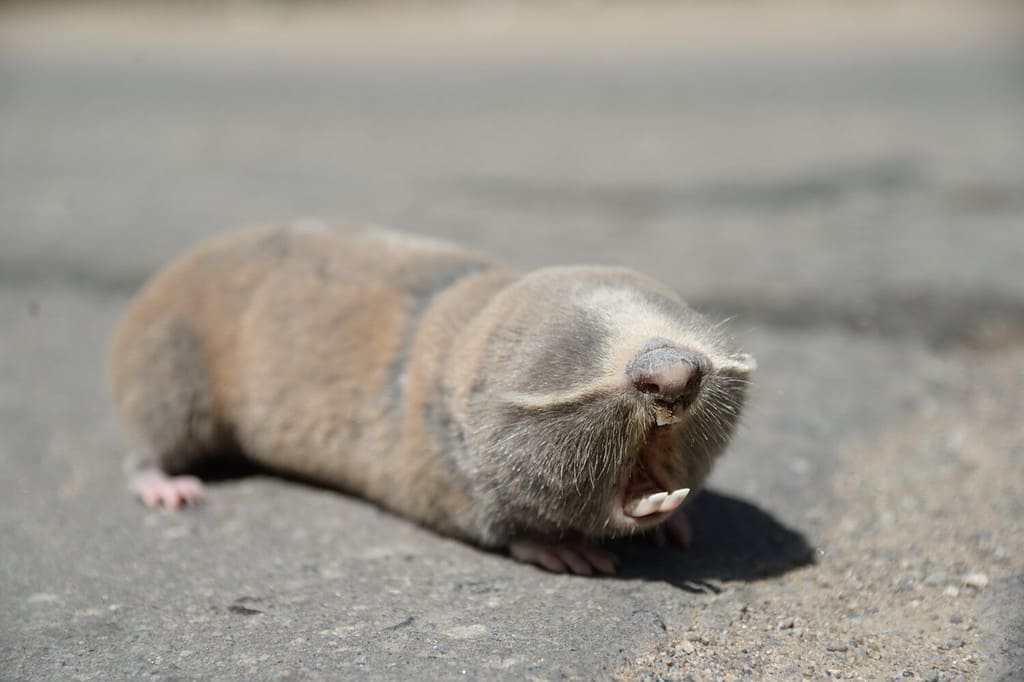
Moles have tiny eyes and typically use their other senses to locate prey.
©EvgenS/Shutterstock.com
The mole, a small burrowing mammal, has eyes that are relatively small in proportion to its body size. Adapted for a life underground, moles spend most of their time in dark tunnels and rely on their other senses, such as their highly sensitive snouts and touch-sensitive fur, to navigate and locate prey. While their small eyes may not provide exceptional visual acuity, they serve a purpose in detecting changes in light and shadows as the mole moves through its subterranean habitat. These small eyes, protected by a layer of fur, help the mole avoid injury and debris while tunneling, contributing to its remarkable ability to thrive in an invisible world beneath the surface.
7. Elephant:
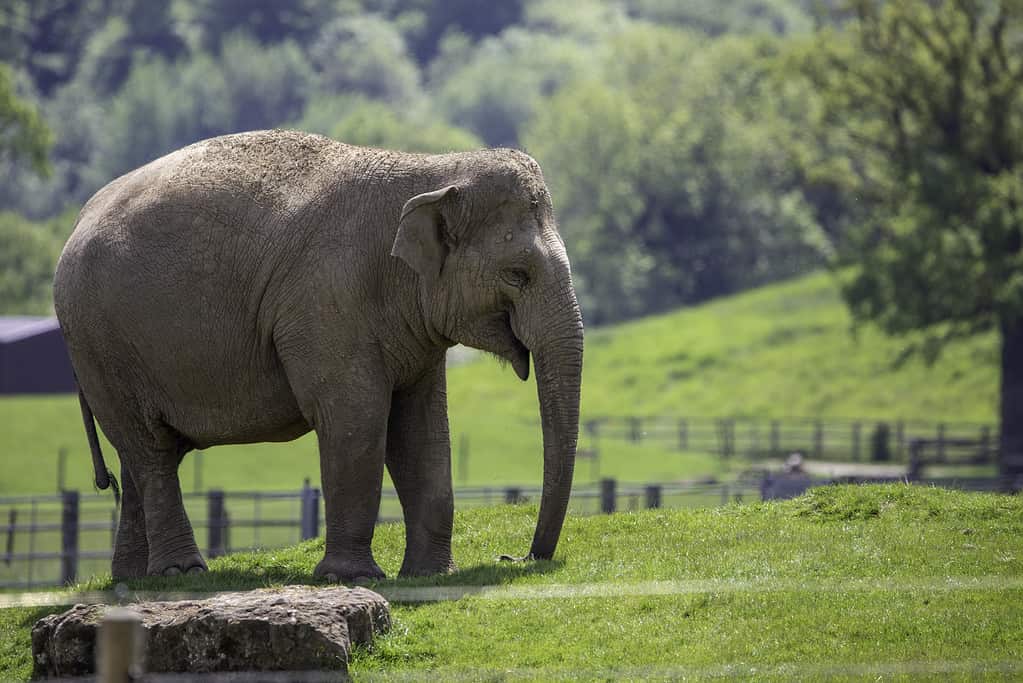
A beautiful view of an adult
elephant
walking in ZSL Whipsnade Zoo, United Kingdom – compared to their bodies, elephants have pretty small eyes.
©Wirestock/iStock via Getty Images
Despite their massive size, elephants have relatively small eyes in proportion to their bodies. These gentle giants possess eyes that are beautifully adapted to their environment. While their visual acuity may not rival that of some other animals, elephants have excellent peripheral vision, allowing them to perceive movement and objects around them. Their small eyes are protected by long eyelashes and a set of tough eyelids, shielding them from dust and debris. Elephants rely on their keen sense of smell, acute hearing, and social communication to navigate their surroundings and interact with their herd members. Although their eyes may be small, they contribute to the overall magnificence of these intelligent creatures.
8. Mongoose:

Dwarf mongooses have relatively tiny eyes.
©Eugene Troskie/Shutterstock.com
Mongoose species, known for their agility and hunting prowess, have relatively small eyes in proportion to their bodies. These small, dark eyes are adapted to their diurnal (daytime) hunting lifestyle. While their eyes may not possess the same level of visual acuity as some other animals, mongooses rely on their other senses, such as their exceptional sense of smell and sharp hearing, to locate prey and detect potential threats. Their small eyes are well-suited for their terrestrial lifestyle, allowing them to navigate through varied environments and react swiftly to changes in their surroundings. The mongoose’s ability to thrive with small eyes showcases the remarkable adaptability and resourcefulness of these fascinating creatures.
9. Wombat:
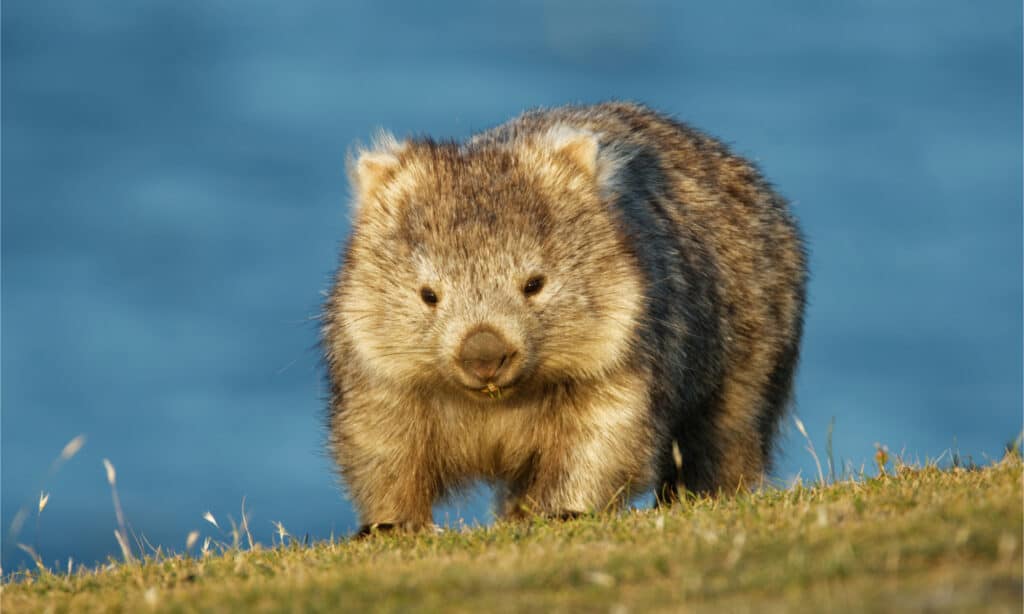
Common Wombat in the Tasmanian scenery, eating grass in the evening on the island near Tasmania.
©Martin Pelanek/Shutterstock.com
Wombats, stout marsupials native to Australia, have relatively small eyes in proportion to their bodies. These small, round eyes contribute to the overall appearance of these adorable creatures. While wombats may not possess exceptional visual acuity, their eyes play an important role in their survival. Wombats are primarily nocturnal animals, relying on their keen sense of smell and acute hearing to navigate and locate food in the darkness. Their small eyes, protected by a layer of fur and tough skin, help them detect changes in light and shadows as they move through their habitat. Despite their small size, the eyes of wombats are a vital sensory tool in their quest for survival in the Australian bush.
10. Shrew:

Shrews have incredibly small eyes and rely mostly on their sense of smell to locate prey.
©iStock.com/Imagesines
Shrews, small insectivorous mammals, possess eyes that are relatively small in proportion to their bodies. These tiny, beady eyes contribute to their overall appearance and are adapted to their lifestyle as active hunters. Shrews have a rapid metabolism and a need for constant foraging, which is facilitated by their small eyes. Although their vision may not be as acute as some other animals, shrews rely on their exceptional sense of smell and touch to locate prey and navigate their surroundings. Their small eyes, set on the sides of their heads, provide a wide field of vision, allowing them to detect predators or potential sources of food. Despite their small size, shrews thrive with their unique adaptations and demonstrate the diversity of nature’s creations.
The photo featured at the top of this post is © Chiswick Chap/CC BY-SA 3.0
Thank you for reading! Have some feedback for us? Contact the AZ Animals editorial team.






